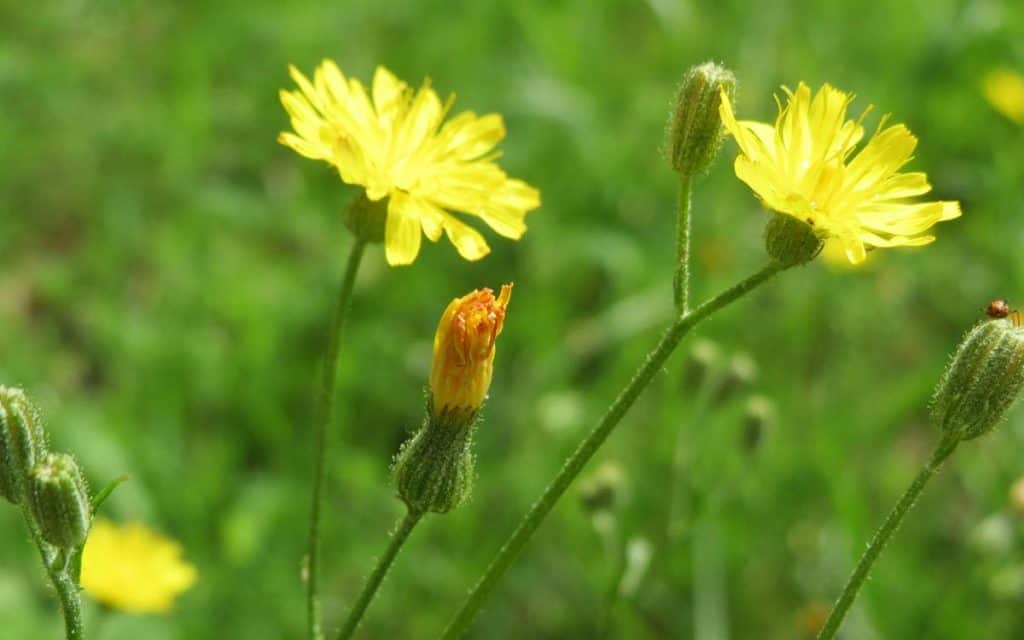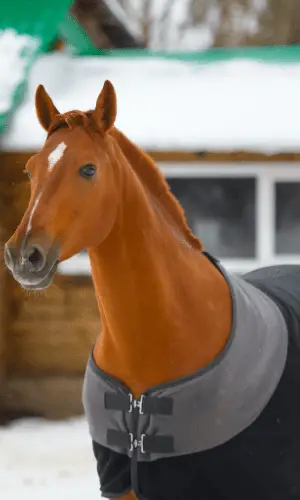I have noticed a severe over flexion on my horse’s hind limb when he’s walking or trotting. It’s more evident when turning on the affected leg, backing up slowly, or when I suddenly frighten him.
Stringhalt in horses is the spasmodic contraction of the hind legs’ lateral extensor tendons. Although the condition is painless, it shows the horse is unsound. If it persists, the animal may be unable to walk properly.
[toc]
What is Stringhalt in Horses
Stringhalt causes the horse to over flex when walking, to the point of hitting its abdomen with its hind leg. In such a case, the animal suspends its leg more than it does in a normal movement. It also drops the limb back quickly, thus slapping the ground hard and flat.
Therefore, stringhalt is a non-painful neuropathic condition, which is shown by this abnormal hind limb gait. You will notice this when your horse is walking forward or backward.
Initially, I thought the horse was suffering from shivers, EPM, stifle, or locking patella. You may also be wondering what the difference between shivers and stringhalt in horses is. Read on for more insight.
Shivers
Shivers mimic stringhalt since they both involve the sudden upward flexion of the hind leg when backing and moving off. However, shivers involve muscular quivering of the horse and tail elevation when making that abnormal movement, but it doesn’t hit the ground hard.
History Of Stringhalt
Stringhalt in horses and hooved animals is an age-less disease that was reported back in the Renaissance period. It is an excessive contraction of the digital extensor muscles, especially when these muscles lack enough opposition.
Clinical Signs
You’re likely to notice your horse kicking its abdomen with its hind leg and quickly slapping the ground hard. It is particularly evident when the horse is backing up or turning. It might also involve the two hind legs, and in extreme cases, the condition may include the forelegs.
Possible Causes Of Stringhalt
Stringhalt in horses is a neurological issue. It’s caused by the damage of the nerves, thus triggering the abnormal activity of spindles. These sensory receptors are responsible for detecting any changes in the length of the muscle.
In this situation, certain muscles contract differently, either early or late, when the horse is moving. It’s a sign that the horse is suffering from a neurological disease caused by toxicity. The abnormal gait may become severe, thus warranting euthanasia, especially when it becomes severely incapacitated.
Types of Stringhalt
There are two common categories of stringhalt in horses:
Australian Springhalt
The disease is caused by the ingestion of toxic plants like common dandelion, cheeseweed, and little mallow, although flatweed remains the main contributor of stringhalt. Generally, these weeds are not extremely toxic; however, their toxic levels may increase due to certain environmental conditions.

For instance, you’re likely to notice this behavior during cold weather, and the symptoms are expected to decrease with hot weather. This type affects both hind legs and, in extreme cases, the front legs.
The animal may recover with time after it stops ingesting these toxic plants. For instance, there were two stringhalt outbreaks in Brazil, and Jose Allan Soares de Araujo, a researcher from the veterinary hospital, conducted research during that period. He fed a young horse with flatweed during this time.
As a result, the horse developed stringhalt signs after three weeks and showed some improvement when the plant was removed from its feeds. This seems to confirm that the suspect weed was the cause of the disease.
Therefore, you need to monitor what your horse is feeding on when you notice this condition, as well as provide a high-quality diet to support its recovery. You may also need to give them laxatives to flush the system or get the weed of the animal’s gastrointestinal system to prevent absorption.
Classic Stringhalt
Classic stringhalt is not associated with plant toxicity, but back or neck injury. Still, its origin is a mystery. Thus, the origin of this condition could be the injury on its neck, back, or leg. Most likely, stringhalt clinical symptoms may improve once these injuries heal.
The animal suddenly jerks its limb upward towards it and drops it to the ground. The action can be mild or violent in classic stringhalt, as the injury deteriorate or when it experiences significant pain in its rear foot that originate from the stifle or hock.
In other situations, there may be no injury, thus making it difficult to determine the cause of the disease. As a consequence, the vet may consider other possibilities such as osteochondritis dissecans (OCD), which is a cartilage disorder at the joints. They may also think of Arthrosis or degenerative joint disease as the cause of the disease. Therefore, continuous training or intensive work may worsen the situation.
Therefore, under this condition, your horse may never recover since the disease keeps on deteriorating with time. It may begin with one rear leg and then progress to the second one, and forelegs.
Some of its treatment is botox, anticonvulsant drugs, muscle relaxants, and surgery. Unfortunately, there is no guarantee that your horse will recover completely. Thus, it’s not advisable to ride it or perform any ground maneuvers.
However, if the horse is frequently used in the field, it needs a thorough neuromuscular examination first, for its extremely risky to ride a horse suffering from stringhalt.
Diagnosis
An equine veterinarian that specializes in neuromuscular dysfunction is an ideal person to evaluate stringhalt symptoms. However, Australian stringhalt doesn’t require thorough diagnostic procedures like classic stringhalt. It just needs monitoring of the feeds to eliminate the ingestion of toxic weeds.

Orthopedic Exam
An extensive orthopedic examination entails ultrasound and X rays of the affected leg to investigate any major issue in the lateral digital extensor muscle, hock, and tendon. The vet may detect abnormalities in the nervous system reflexes that increase the tone in digital extensor muscles whenever the horse is moving.
One of the clinical signs that may be displayed during the examination is hypertonia, which is increased tension, rigidity, and muscles” spasticity. Hypermetria is another outcome, which is the ataxic muscle disorder, demonstrated by overreaching. Therefore, neurological problems are complex, and can only be discovered after a thorough examination.
For that reason, you may need to pursue advanced treatment from a specialist. They will perform additional diagnostic tests to rule out other diseases of the muscles like infectious diseases such as equine protozoal myeloencephalitis (EPM) or polysaccharide storage myopathy (PSSM)
Diagnostic Workup
A horse with stringhalt symptoms may require hospitalization to provide it with close examination for a number of days. Additional clinical examinations include electromyography (EMGs), diagnostic imaging, and orthopedic workup that offer more accurate diagnoses.
With EMG, the vet is able to have a clear reading of what is happening on the muscles, thus eliminating doubts during the treatment of the disease.
Treatment
Stringhalt caused by the ingestion of toxic weeds can be eliminated when the horse is removed from the pasture. You may give the animal magnesium salts and vitamin B complex to help improve its peripheral neuropathies.
The average recovery of such animals is six to nine months or less; however, those that have severe signs of stringhalt in both legs or forelegs may take longer. In that case, additional treatment should be provided.
Muscle Relaxants
The vet will recommend medication that works directly on the central nervous system. The drugs are helpful to horses that have persistent stringhalt problem. Botulinum toxin or Botox is used to alleviate stringhalt clinical signs.
Anticonvulsants
Sedatives can be used to reduce anxiety and provide relief during a severe phase of stringhalt. For that reason, the vet may recommend anticonvulsants and other drugs in acute stages. Sadly these drugs are sedatives, and therefore, they give the animal suffering from stringhalt, only temporary relief.
Phenytoin
Phenytoin (PHT) or Dilantin is an anti-seizure medication used to manage Australian stringhalt. It is used intravenously or by mouth to prevent focal seizures and tonic-clonic seizures. You may notice a significant improvement in the movement of a horse initially suffering from Australian stringhalt. The anti-epileptic medication is mixed with feeds at the rate of 15 mg/kg every 12 hours for the next two weeks.
The objective is to reduce clinical signs of stringhalt, for it hyperpolarizes the horse’s nerve membrane, thus enhancing the potential threshold. Therefore, it dampens the firing of the nerves. Seeking long-term treatment for stringhalt in horses can be risky and expensive. It also contributes to positive doping tests, especially for racehorses.
Surgery
A surgical procedure known as lateral digital extensor tenectomy may be done to remove a section of the tendon, or myomectomy running along the hock and the lateral digital extensor muscle. However, its success rate is not guaranteed, and the horse may never recover.
Nonetheless, in most cases, the procedure is able to alleviate clinical signs associated with stringhalt, and your horse may begin to move.
Common Questions About Stringhalt
Can Stringhalt be cured?
Australian stringhalt is caused by the consumption of toxic weeds in the pasture. Thus, your horse can recover some months after you withdraw the weeds from the pasture. On the other hand, classic stringhalt may be cured or not, particularly in severe cases.
However, you can retrain your horse to get around the condition with the use of Botox. The drug is able to temporarily help the animal to get out of its loop until it’s able to manage the neurological issues.
Your horse can have a good quality of life, although it may not return to its previous performance. It may also experience a relapse, while a horse that had severe clinical signs may recover fully and return to its normal life and activities.
Scientists are actively conducting research on this neurological disease to discover new causes and treatments. They are seeking to understand the origin of stringhalt in horses by conducting post-mortem examinations.
For that reason, they are investigating botulinum toxin (Botox) that is recommended above for calming the clinical signs of stringhalt, for it is used in humans to smoothen facial wrinkles. Researchers have recorded a positive outcome, and are advocating its use in higher doses to reduce stringhalt symptoms.
Is Stringhalt Genetic?
There are no genetic links with stringhalt since all breeds are susceptible. The condition is most evident in horses aged 4-5 years, thus inspiring many to think that it’s caused by genetic predisposition. However, even if there are certain correlations, the condition has several causative factors, hence making it hard to link it to genetics explicitly.
The cause of classic stringhalt is still unclear, although it is thought that the disease could be triggered by traumatic damage of sensory nerves of the muscle on the hind limbs.
Can You Ride a Horse with Stringhalt?
A hopping gait shows that the degree of equine reflex hypertonia in your horse is severe. Some horses may still work without impairment, but it’s technically unsound. Although stringhalt is not a response to pain and your horse may not be uncomfortable, it’s still not wise to ride on it or engage in aspects like dressage.
Summing It All Up
Stringhalt in horses is basically an outward sign that the animal is suffering from a neurological disease. Although the Australian stringhalt type is caused by the ingestion of toxic weeds such as flatweeds, the origin of the classic type is still unknown.
A horse with this condition yanks its legs up and halts them whenever it is turning, backing up or walking. Thus, stringhalt is an uncontrollable exaggerated movement. The symptoms may disappear after a few days when you remove the animal from the poor pasture. More so, you may provide the horse with a high-quality diet to speed up the recovery process.
However, if the persist, additional treatment may be necessary, and this may include the use of phenytoin or worse still surgery. Nevertheless, most of the treatment procedures are risky and costly as well as they don’t guarantee that the horse will remove and resume its previous performances.









2 thoughts on “Stringhalt in Horses What You Need To Know”
you didn’t mention the prevalance of stringhalt in draft animals and cross breeds of the draft horses .
In my hunter jumper practice I see it most often in crosses with fresions, all draft breeds and warm bloods.
I rarely do the tendonectomy anymore except in refractory cases because the use of dexametasone stops it temporaly long enough to compete successfully as a jumper or trail animal.
AS a side bar I bred a very fast mule out of a black type thourghbred mare that had a very successful racing career that exhibited extreme stringhalt in the left rear when she walked past the grandstands in the post parade but when the gate opened showed no sign of it and won EVERY race over 400 yards or more. I rode this mule every where on trails and she never exhibited stringhalt except in the post parade . I won considerable money betting on her because the betters thought she was crippled. I never medicated the animal with any thing fyi
Bob Bradley ,Dvm
I’m looking at an 18 year old Morgan gelding. Was told that he has mild stringhalt. I’m feeling apprehensive about buying him.